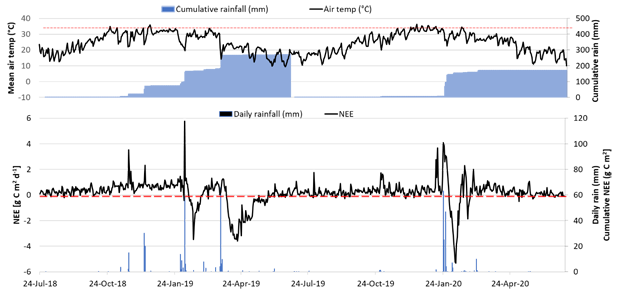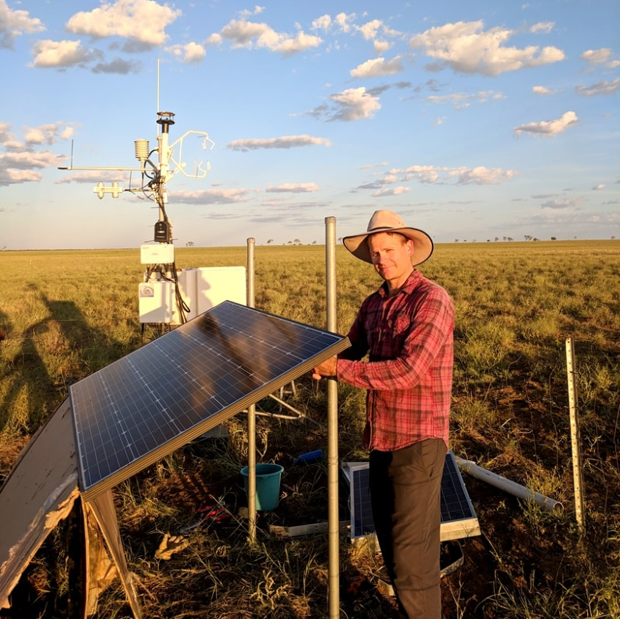
This month's site feature has us moving to the opposite end of Australia from Boyagin in WA, to the vast grassy plains of northwestern Queensland – the Mitchell Grass Rangeland site.
Established as a much needed ecosystem research site in 2015, the Mitchell Grass Rangeland became an OzFlux and TERN SuperSite  in 2018 when a flux tower was installed. The site is co-managed by Professor Peter Grace
in 2018 when a flux tower was installed. The site is co-managed by Professor Peter Grace  and Associate Professor David Rowlings
and Associate Professor David Rowlings  from the Queensland University of Technology (QUT). The traditional owners where the flux tower is located are the Iningai people.
from the Queensland University of Technology (QUT). The traditional owners where the flux tower is located are the Iningai people.
Grasses as far as the eye can see
Situated near Longreach in the northwestern region of Queensland, the Mitchell Grass Rangelands flux tower provides much needed information about the ecosystem processes occurring in Australia's most extensive tussock grassland. Mitchell grasses, or Astrebla spp., are widespread across much of Australia. But in the Mitchell rangelands region, they dominate a vast treeless area stretching from Queensland into the Northern Territory (i.e. Sturt Plains OzFlux site near Tennant Creek).
The region is primarily located in the tropical and semi-arid zones of northern Australia, where rainfall patterns are influenced by the summer monsoon. Annual rainfall at the Mitchell Grass Rangelands site is nearly 450 mm and temperatures range from as hot as 46 °C in the summer to -3 °C in the winter, where frost events can occur across much of the land surface.
'The alkaline clay soils of these regions have a high potential for sequestering soil carbon. Small increases in soil carbon across the nearly 50 Mha of the Mitchell Grass Rangelands makes an invaluable contribution to offsetting Australia's greenhouse gas emissions' - Prof. Peter Grace
Panoramic view from the tower at Mitchell Grass Rangelands (credit: David Rowlings).
Measuring a significant agricultural landscape in Australia
The extensive land area occupied by the Mitchell grass rangelands supports important sheep and cattle grazing industries. The flux tower is located within this agricultural landscape, thus providing important information about how changes in management practices, such as livestock stocking rates and grazing intensity, impact the Mitchell grass ecosystem.
Closely tied in with agricultural management in the region is the regular occurrence of drought, which can significantly reduce grass growth and impact on agricultural productivity. Through measuring carbon, water and energy fluxes, as well as changes in meteorological variables, the flux tower provides much needed information about how climate and land management are shaping the Mitchell grasses of this region.
'The Mitchell grasslands are well adapted to drought however the extreme climatic variability of this region of Australia makes them highly sensitive to total grazing pressure, which is livestock plus native animals.
We are using the SuperSite to examine the impact of grazing pressure on pasture growth, cover and soil carbon, as well as collecting critical carbon cycling and soil stabilisation data for improving biogeochemical models to predict how nutrient cycling in these marginal grasslands will be impacted by climatic change and variability' – Assoc. Prof. David Rowlings
PNet ecosystem exchange (NEE) timeseries over two years of measurement at the Mitchell Grass Rangeland site, including mean daily air temperature and rainfall. Note the response of NEE to large rainfall events (credit: Peter Grace).
QUT's Assoc. Prof. David Rowlings working at the Mitchell Grass Rangelands OzFlux site (Credit: David Rowlings).
Recent field activities at Mitchell Grass Rangelands tower
A long-term trial looking at the interaction of rainfall and plant litter decomposition and carbon stabilisation in the soil has just had the second sampling event completed. The trial is using isotopically labelled 13C and 15N litter placed in soil mesocolumns under different rainfall regimes (50, 100 and 200% rainfall) to trace the movement and stabilization of C and N in the soil. Cores are collected at 1, 2, 4 and 6 years after commencement.
Two total grazing pressure exclusion cages have been installed at the site and will be sampled quarterly for biomass growth.
Acoustic sensors have also been installed as a cost-effective means of assessing the impact of grazing practices on biodiversity.
Lastly, a cosmic ray sensor is due for install in September, which will provide additional soil moisture monitoring capability.





